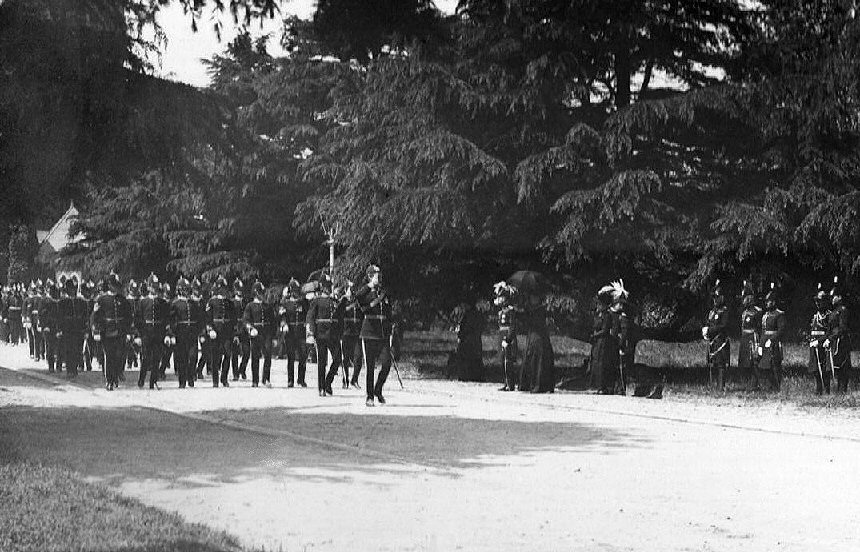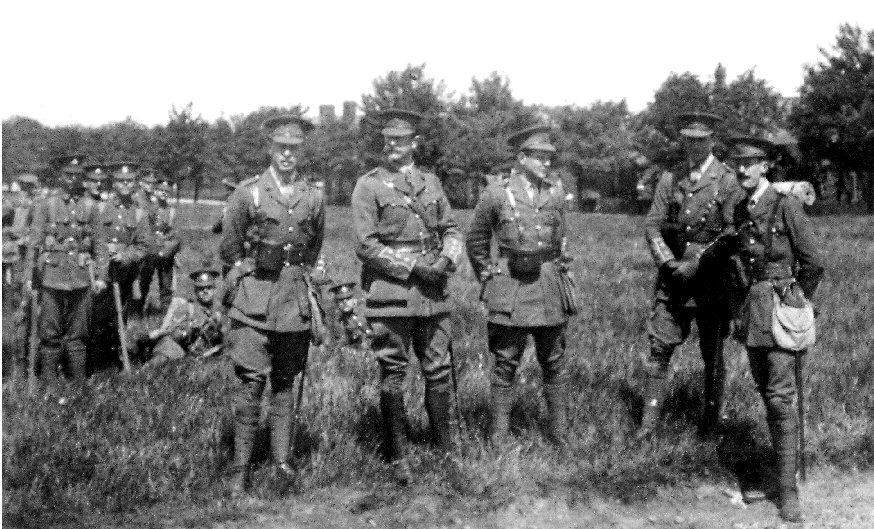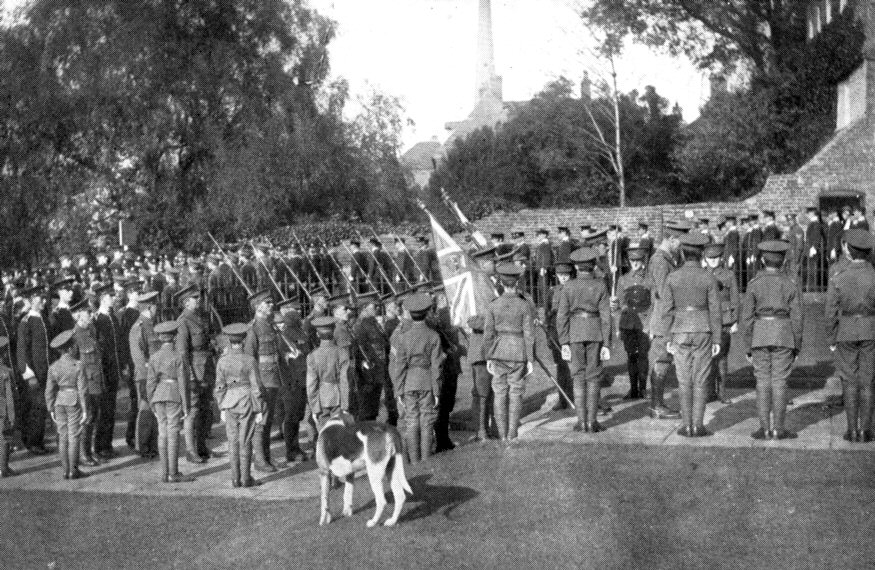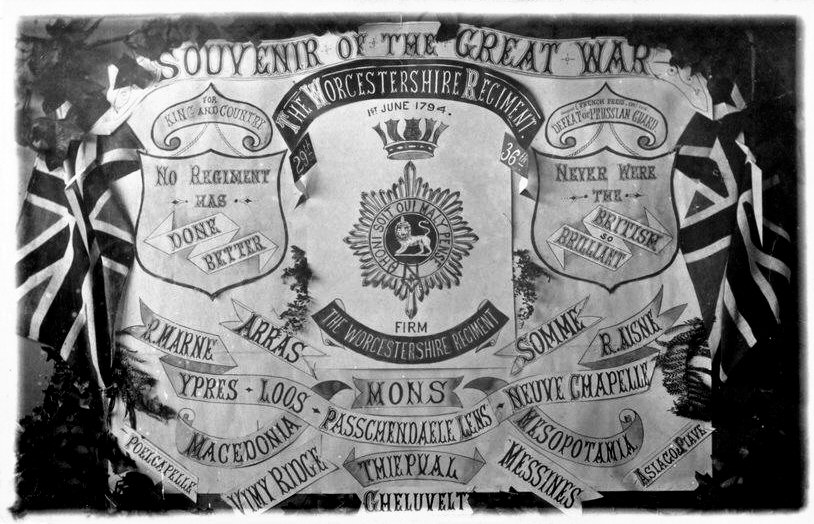Worcestershire Regiment goes to War
On the 28th June 1914 a Serbian zealot had assassinated the Austrian Archduke Franz Ferdinand. On July 23rd the Austrian Government delivered their ultimatum, and on July 29th the Austrian guns opened fire on Belgrade. Russia, Germany and France mobilised in quick succession.
On August 2nd came the Kaiser's ultimatum to Belgium, and at 4 p.m. on the 4th August 1914 to every station of the British Army was flashed the order for Mobilization.

2nd Battalion Worcestershire Regiment church Parade (Aldershot, June 1914)
Marching past King George V and the Queen and Sir Douglas and Lady Haig
This would be the last Church Parade at Aldershot before war started. Captain Gerald Ernest Lea at the head of the 2nd Worcestershire would be killed in action on the 15th September 1914 (having died of his wounds the same day during heavy fighting on Tilleul heights during the battle of the Aisne).
The order for moblization was received, both at Aldershot and at Tidworth, in the evening of the 4th August 1914, and during the ensuing week all ranks of the 2nd Battalion and the 3rd Battalion Worcestershire Regiment were busily employed in completing their preparations for War. The Battalions had to be filled up to war strength by reservists, weapons had to be made ready, equipment and ammunition received and issued, stores of all kinds taken into use.
Officers and men had to be medically inspected and passed fit for service, additional horses had to be received and taken over, regimental property had to be placed in safe keeping.
Most precious of all, the Colours of the two Battalions, the symbols of their history and of their loyalty, had to be laid away. They were taken to Worcester by special escorts and handed to the care of the Dean and Chapter to be preserved in the Cathedral until the Battalions should need them.
Worcester, when the Colour Parties came, was seething with activity. The Depot at Norton was crowded out with reservists and with volunteers for service, who were sleeping all over the cricket ground and the adjoining fields. The spirit of the reservists was splendid, and the parties of reinforcements entrained to join their Battalions amid scenes of great enthusiasm.
During the second week in August the mobilization was completed. Then for some days the Battalions stood fast awaiting orders—days of tense excitement and speculation while the Reservists were settling down and while everything was in the state of general disorder and discomfort which always precedes a move.
Every man should have been in possession of two pairs of boots. But already it had been decided to form "New Armies" and in view of the shortage of all military equipment the second pair of boots were withdrawn from most units of the Expeditionary Force. The 2nd and 3rd Worcestershire would leave for France with only one pair of boots per man—a shortage which later was to have most trying effects.

2nd Battalion Worcestershire Regiment - Officers of 'D' Company
L to R: Lieut. F. E. Middleton-Gavey, Captain G. E. Lea, 2/Lieut. H. P. Hartnoll, Lieut. R. E. Vyvyan, Captain J. P. L. Stoney
No formal alliance had existed before the War between England and France, but the development of the "Entente" had resulted in certain arrangements for concerted action if the necessity should arise. It had been arranged that such troops as might be sent from England to France could operate as a more or less independent force; but no fixed plan had been made before the War, and no definite decision was made until 6th August 1914. Then the British Government decided to despatch a force of four Divisions and one cavalry Division. Subsequently it was decided that this force should be concentrated in the area south-west of the frontier fortress of Maubeuge, on the left or northern flank of the long French battle-line.
The movement of the British Expeditionary Force to France began on the 9th August 1914 and was conducted with such secrecy and efficiency that for several days the move remained unknown to the enemy.
The 2nd and the 3rd Battalions of the Worcestershire Regiment both received their orders on the 12th August 1914. Early on the morning of August 13th the 2nd Battalion marched down to the Government siding at Aldershot and entrained. The two trains which carried the Battalion left Aldershot at 7 a.m.
and 8 a.m. respectively and three hours later arrived at Southampton Docks. The two half-battalions were embarked on board the transport ships "Lake Michigan" and "Herschel." All the rest of that day the ships lay in Southampton Docks. Not until after nightfall did the first of the two transport ships sheer off and steam down the quiet Southampton Water, past the darkened lights and the patrolling torpedo boats, out into the Channel.
In the afternoon of the following day (August 14th) the "Lake Michigan" entered the harbour of Boulogne. The half-battalion disembarked and marched through the narrow cobbled streets to a prepared rest camp, the "Camp de Marlborough," on the hill above the town. The British troops were enthusiastically received by the populace and by the French Territorial battalions guarding the port.
Three hours later the "Herschel" likewise came into Boulogne, and the second half-battalion joined the leading companies.
All the next day the Battalion lay in the camp on the hill amid constant bustle and stir of troops arriving. In the evening the lines of the Battalion were visited by Field-Marshal Sir John French and by the French Commander-in-Chief, General Joffre.
Close on midnight (August 15th/16th) the Battalion paraded and marched down to sidings near Boulogne Station, where they entrained and were carried eastwards to the concentration areas.
Meanwhile the 3rd Battalion Worcestershire Regiment also had moved across the Channel. The Battalion left Tidworth a few hours before the 2nd Battalion had left Aldershot, and arrived at Southampton at 7 a.m. on August 13th; but it was not till early on the following day that the transport ship s.s. (steam ship) "Bosnian" sailed.
Before dawn on August 15th the s.s. "Bosnian" cast anchor off Havre. The great roadstead was filled with crowded transports; and owing to the state of the tide it was not until the following day that it was possible for the troopship to go on to its eventual destination at Rouen. At 1.30 p.m. on August 16th the "Bosnian" sailed on her way up the Seine.
Few river voyages are more impressive than that up the Seine, with its vistas of rolling forests and picturesque Norman villages. The inhabitants on the banks cheered the troops, and excitement on board ran high. At 9 p.m. the Battalion disembarked on the broad quays of Rouen, where they passed the night billeted in a long shed next to the ship. Early next morning the 3rd Battalion Worcestershire Regiment marched through the streets of Rouen to the station and entrained for the front.
The 1st Battalion Worcestershire Regiment which was stationed overseas when war broke out was ordered to return home. They sailed from Alexandria on board the troopship "Deseado" on 30th September 1914. The voyage home had not been without incident, for the French battleships escorting that convoy had insisted on taking their proteges to Marseilles instead of allowing them to go home via Gibraltar. But the mistake was rectified and, after a short delay at Gibraltar, the convoy from Egypt passed unmolested up the coast of Portugal (from Gibralter onwards the convoy was escorted by H.M.S. "King Alfred.") and across the Bay. Southampton had been the original destination, but a scare of German submarines caused the route to be changed, and it was at Liverpool that the Battalion arrived at 9.15 p.m. on the 16th October 1914. The night was spent in disembarking the troops and stores, and at dawn next morning (October 17th) the Battalion entrained for Winchester.
The 1st Battalion Colours were now brought back to Worcester by a Colour Party which was under the command of Major E. C. F. Wodehouse, D.S.O., with Captain J. F S. Winnington and Lieutenants T. Fitzjohn and L. G. Phillips and were temporary lodged in the Guildhall on the 22nd October 1914. The men of the Colour Party were housed in a hotel near the Severn Bridge and were well looked after for the next few days.
Of the officers Major E. C. F. Wodehouse, D.S.O. would later be killed in action on the 12th March 1915, whilst commanding the 1st Battalion. Captain J. F S. Winnington would also later die of wounds whilst commanding a battalion of the Northhamptonshire Regiment.
On the 24th October 1914, the Colour Party was escorted from the Guildhall to Worcester Cathedral by three companies of the 8th (Home Service) Battalion Worcestershire Regiment, commanded by Colonel Dixon. The band of the 8th Battalion, under Bandsmaster E. Davies, headed the procession. There was also a detachment from Norton Barracks. The Lord Lieutenant (Lord Coventry) took part in the procession and services, as did the Mayor of Worcester (Alderman H. A. Leicester) and the members of the Corporation.

1st Battalion Worcestershire Regiment laying up their Colours at Worcester Cathedral on the 24th October 1914
The photo above shows the Colour Party and escort about to enter the Cathedral by the West Door. Major E. C. F. Wodehouse, D.S.O., is leading, followed by Captain Winnington. Lieutenant Fitzjohn is carring the King's Colours, nearest the camera, and Lieutenant Phillips the Regimental Colours. Behind the N.C.O.'s of the 1st Battalion come the men of the 8th (Home Service) Battalion in red coats. Lining the paths are boys of the King's School O.T.C.
The climax of the service was when the Colour Party advanced to the Chancel steps, and with the words Major Wodehouse handed over the Colours;
"In the name of the 1st Battalion Worcestershire Regiment I present these Colours to be taken care of in the Cathedral Church, the Mother Church of the County, and to remain for the present under the guardianship of the Church."
Receiving them, the Dean (The Very Rev. Dr. Moore Ede) replied;
"In the name of the Dean and Chapter I receive these Colours to be placed and taken care of in the Cathedral Church while you are fighting the battles of your country."
The Colours were then placed on either side of a Rood Screen.
Then followed an uncomfortable fortnight of training at Hursley Park near Winchester, where the 8th Division was in process of formation. At noon on the 5th November 1914, the Division marched out of Hursley Park to Southampton. Through the streets of that town the march of the long column was watched and cheered by large crowds. The Battalion marched down to the docks and went straight on board the transport ship "Maidan". Just before midnight the ship sailed. At dawn next morning the troopships carrying the 8th Division reached Havre. There the Battalion remained on board the transport for two days, first in the open roadstead and then alongside the docks. The delay was due to lack of facilities for landing the horses and heavy vehicles of the Division.
On the morning of November 8th the 1st Worcestershire disembarked and were accommodated in a huge shed at the dock side. Not till 5 p.m. next day (November 9th) did the Battalion entrain for the front. The train slowly journeyed through Abbeville to Berguette, which was reached after dark on the 10th. The Battalion detrained and found billets close to the railway siding.
Next day the Battalion marched twelve miles through Merville to Neuf Berquin. There for three days the Battalion lay in billets while the other units of the Division assembled.

